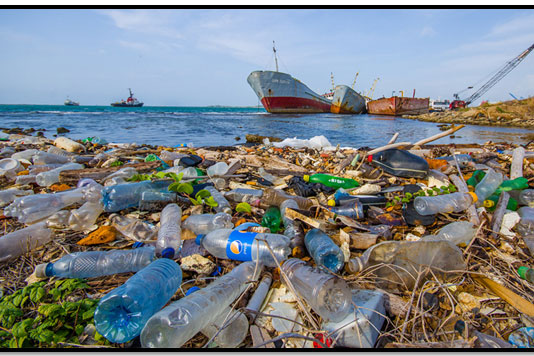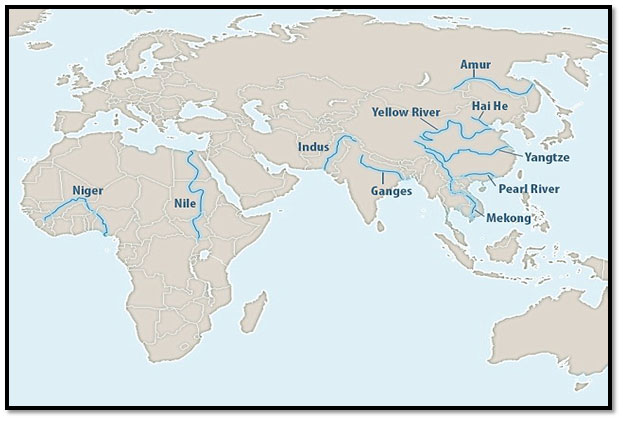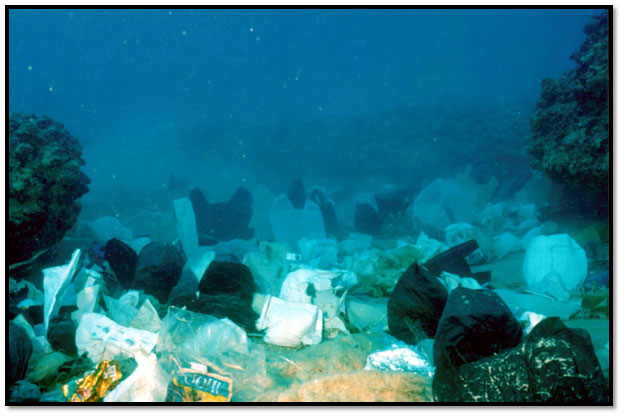
New Delhi:Increasing plastic waste that our rivers harbour is a huge matter of concern; a newGermany-based study has found.
According to the research, up to 95 percent of the plastic polluting the world's oceans comes from just 10 rivers, including the Ganges and these 10 rivers transport 88-95 percent of the global plastic load into the sea.
Scientists analysed 79 sampling sites along 57 rivers for microplastic particles measuring less than 5 mm and macroplastic above the size.
Massive amounts of plastic bits that imperil aquatic life are washing into the oceans and even the most pristine waters.But how it all gets there from inland cities has not been fully understood.
Now a study shows it is because of the mismanagement of waste. Researchers said that, the rivers with the highest estimated plastic loads are characterised by high population - for instance the Yangtze with over half a billion people.
These rivers are also in countries with a high rate of mismanaged plastic waste (MMPW) production per capita as a result of a not fully implemented municipal waste management including waste collection, dumping and recycling.
Researchers at The Ocean Cleanup—a Dutch foundation developing new technologies for ridding the oceans of plastic—said, rivers carry an estimated 1.15-2.41 million tonnes of plastic into the sea every year, an amount that need between 48,000 to over 100,000 dump trucks to carry it away.
The study follows a recent report that pointed the finger at China, Indonesia, the Philippines, Thailand, Sri-Lanka and Vietnam for spewing out most of the plastic waste that enters the seas.
Research Findings:
Previous research has also suggested two-thirds of plastic comes from the 20 most contaminated rivers. The Yangtze has been estimated in previous research to dump some 727 million pounds of plastic into the sea each year. The Ganges River in India is responsible for even more - about 1.2 billion pounds.
A combination of the Xi, Dong and Zhujiang Rivers (233 million lbs per year) in China as well as four Indonesian rivers: the Brantas (85 million lbs annually), Solo (71 million pounds per year), Serayu (37 million lbs per year) and Progo (28 million lbs per year), are all large contributors.
This time also the recent findings published in the journal Environmental Science & Technology showed that two-thirds of the pollution comes from the 10 most polluting rivers, the overwhelming majority in Asia with the Yangtze River in China topping the list.

The Yangtze, which is the world's third-longest river, is the largest contributing catchment, dumping some 330,000 tonnes of plastic into the East China Sea.
This is followed by the Ganges River in India and a combination of the Xi, Dong and Zhujiang Rivers in China as well as four Indonesian rivers: the Brantas, Solo, Serayu and Progo.
The rest of the world shared the remaining 14 percent of plastic pollution via rivers; The Ocean Cleanup researchers said.
The study comes against the backdrop of the UN's first ocean conference opening in Miami on Monday, where plastic pollution was singled out as particularly harmful.
UN Secretary General Antonio Guterres cited a recent study that showed plastic could outweigh fish in 2050 if nothing is done.
Every year, more than eight million tons of plastic ends up in the ocean, costing at least $8 billion (7.1 billion euros) in damage to marine ecosystems and killing an estimated one million sea birds, 100,000 sea mammals and untold numbers of fish.
The team calculated halving plastic pollution in these waterways could potentially reduce the total contribution by all rivers by 45 per cent.
Rivers which flow from inland areas to the seas are major transporters of plastic debris but the concentration patterns aren't well known. But the findings could help fill in this knowledge gap.

Plastic, a Nightmare:
We're surrounded by plastic. Think about every piece you touch in a single day: grocery bags, food containers, coffee cup lids, drink bottles, straws for juice boxes — the list goes on and on. Plastic may be convenient, but its success carries a steep price.
In the first decade of this century, we made more plastic than all the plastic in history up to the year 2000. And every year, billions of pounds of plastic end up in the world's oceans.
Most ocean pollution starts out on land and is carried by wind and rain to the sea. Once in the water, there is a near-continuous accumulation of waste. Plastic is so durable that the EPA reports “every bit of plastic ever made still exists.”
Plastic bags never biodegrade, but they do breakdown. As they do so, any toxic additives they contain—including flame retardants, antimicrobials and plasticizers—will be released into the environment. Many of these chemicals may disrupt the endocrine system—the delicately balanced set of hormones and glands that affect virtually every organ and cell in the bodies of humans and animals.
Due to its slow degradation process, plastics can severely affect living organisms, especially marine life, through entanglement, direct ingestion of plastic waste, or through exposure to chemicals within plastics that cause interruptions in biological functions.
For humans, plastics can cause disruption of the thyroid hormone axis or hormone levels.
Marine plastic pollution costs more than £6 billion ($7.9 billion) in damage to marine ecosystems and has impacted at least 267 species worldwide, including 86% of all sea turtle species, 44% of all seabird species and 43% of all marine mammal species. The impacts include fatalities as a result of ingestion, starvation, suffocation, infection, drowning, and entanglement.
Today billions of pounds of plastic can be found in swirling convergences making up about 40 percent of the world's ocean surfaces. Plastic never goes away. And it's increasingly finding its way into our oceans and onto our beaches….
Researchers said: ‘Pollution of the marine environment with plastic debris is widely recognised and is of increasing ecological concern because of the chemical persistence of plastics and their mechanical fragmentation to so-called microplastics which can be ingested by even small organisms such as zooplankton.’
A Heavy Toll:
On Wildlife- Thousands of animals, from small finches to great white sharks, die grisly deaths from eating and getting caught in plastic:
Fish in the North Pacific ingest 12,000 to 24,000 tons of plastic each year, which can cause intestinal injury and death and transfers plastic up the food chain to bigger fish and marine mammals. A study found that a quarter of fish at markets in California contained plastic in their guts, mostly in the form of plastic microfibers.
Sea turtles also mistake floating plastic garbage for food. While plastic bags are the most commonly ingested item, loggerhead sea turtles have been found with soft plastic, ropes, Styrofoam, and monofilament lines in their stomachs. Ingestion of plastic can lead to blockage in the gut, ulceration, internal perforation and death; even if their organs remain intact, turtles may suffer from false sensations of satiation and slow or halt reproduction. Tragically, the most current research indicates that half of sea turtles worldwide have ingested plastic.
Hundreds of thousands of seabirds ingest plastic every year. Plastic ingestion reduces the storage volume of the stomach, causing birds to consume less food and ultimately starve. Nearly all Laysan albatross chicks — 97.5 percent — have plastic pieces in their stomachs; their parents feed them plastic particles mistaken for food. It's estimated that 60 percent of all seabird species have eaten pieces of plastic, with that number predicted to increase to 99 percent by 2050. Based on the amount of plastic found in seabird stomachs, the amount of garbage in our oceans has rapidly increased in the past 40 years.
Marine mammals ingest and get tangled in plastic. Large amounts of plastic debris have been found in the habitat of endangered Hawaiian monk seals, including in areas that serve as pup nurseries. Entanglement deaths are severely undermining recovery efforts of this seal, which is already on the brink of extinction. Entanglement in plastic debris has also led to injury and mortality in the endangered Steller sea lion, with packing bands the most common entangling material.
On humans- Plastic waste is a menace that is the result of industrialization and to an extent, human activities, without realizing that it ends up affecting our health as well.
As plastic debris floats in the seawater, it absorbs dangerous pollutants like PCBs, DDT and PAH. These chemicals are highly toxic and have a wide range of chronic effects, including endocrine disruption and cancer-causing mutations. The concentration of PCBs in plastics floating in the ocean has been documented as 100,000 to 1 million times that of surrounding waters. When animals eat these plastic pieces, the toxins are absorbed into their body and passed up the food chain.
Also as plastics break apart in the ocean, they also release potentially toxic chemicals such as bisphenol A (BPA), which can then enter the food web. When fish and other marine species mistake the plastic items for food, they ingest the particles and pass toxic chemicals through the food chain and ultimately to our dinner plates.
Plastic pollution affects our economy, costing us untold dollars spent in beach cleanups, tourism losses and damages to fishing and aquaculture industries. Beaches and oceans have turned into landfills littered with plastic and garbage.
Ends
References:
http://zeenews.india.com
https://www.inshorts.com
https://phys.org
http://www.dailymail.co.uk
http://www.biologicaldiversity.org
